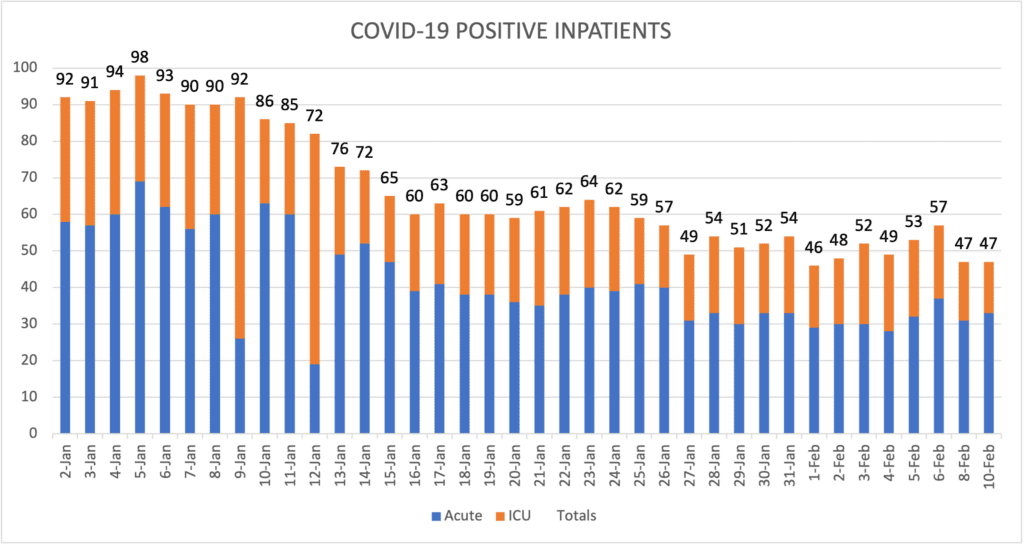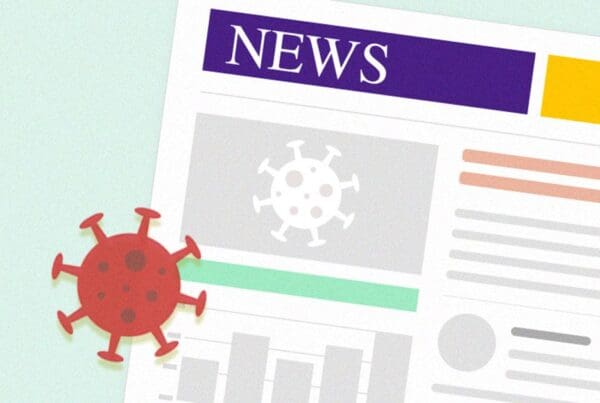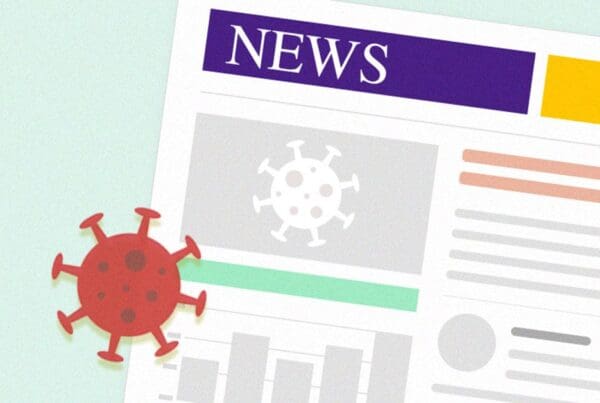Data Snapshot
UW Medicine Hospitals:

King County: The county reported 66 new positive cases and 0 new deaths on Feb. 11.
Washington: The state reported 308,392 cases and 4,603 deaths as of Feb. 9.
United States: The CDC reports 27,030,549 cases and 466,465 deaths as of Feb. 10.
Global: WHO reports 106,991,090 confirmed COVID-19 cases and 2,347,015 deaths as of Feb. 11.
Numbers update frequently, please follow links for most up-to-date numbers.
UW Medicine COVID-19 Vaccine Distribution Update
Total Vaccine Doses Administered: 76,073
- Total first dose: 54,213
- Total second dose: 21,860
As of Feb. 9, 2021.
COVID-19 Literature Report
COVID-19 Literature Situation Report is a daily (M-F) newsletter put together by the Alliance for Pandemic Preparedness that provides a succinct summary of the latest scientific literature related to the COVID-19 pandemic.
Key Takeaways: COVID-19 Literature Situation Report Feb. 10, 2021
- Sera from individuals who had received the Pfizer/BioNTech vaccine showed equivalent neutralization against SARS-CoV-2 viruses engineered to include key mutations from variant strains emerging from the UK (69/70-deletion + N501Y + D614G) and South Africa (E484K + N501Y + D614G). The authors suggest this indicates a minimal impact of these mutations on neutralization by sera from vaccinated individuals, but the impact on vaccine efficacy is unknown. More.
- Wearing a cloth mask over a medical procedure mask (double masking), or knotting the ear loops of a medical procedure mask, then tucking in and flattening the extra material near the face were found by the CDC in experiments to reduce exposure from simulated cough particles. More.
- A systematic review and meta-analysis of SARS-CoV-2 transmission indicated that the highest transmission rates were within households, with a pooled secondary attack rate of 21%. The secondary attack rate increased when the duration of household exposure was longer than 5 days. More.
COVID-19 Literature Surveillance Team, is an affiliated group of medical students, PhDs and physicians keeping up with the latest research on SARS-CoV-2 / COVID-19 by finding the newest articles, reading them, grading their level of evidence and bringing you the bottom line.
Read the latest report: Feb. 10 | Daily COVID-19 LST Report.
Listen to the latest podcast: Feb. 1 | COVID-19 LST Podcast.
UW Medicine in the News
Vox: We wiped out the flu this year. Could we do it again?
Featuring: Helen Chu, MD, MPH, Allergy and Infectious Diseases
“Scientists don’t know, precisely, which Covid-19 public health steps are contributing most to the drop in flu cases. But they have suspicions. “It is the lack of travel, the school closures, and the distancing and masking that are making the biggest difference,” says Helen Chu, a physician and epidemiologist at the University of Washington who studies the flu. It’s hard to definitively say which contributes the most. ‘The flu disproportionately makes children sick or puts them in the hospital, and so things like school closures have a greater effect on flu than they would for SARS-CoV-2,’ Chu says. But then, ‘I can’t imagine school closures are doing most of it, because so many places have managed to keep schools open and they still don’t have flu: Australia, for example. They still kept the schools open, and they had no flu.’ While scientists don’t currently know how much each intervention is contributing to the drop in flu this year, they see opportunities to learn more.
Physics World: Adaptable biosensor rapidly detects COVID-19 virus and antibodies
Featuring: David Baker, PhD, Institute for Protein Design
“The ongoing COVID-19 pandemic has highlighted just how important it is to be able to accurately detect the tiny virus particles that cause diseases. A new method, recently described in Nature, can rapidly indicate the presence of proteins from a coronavirus and can be easily adapted to detect a wide variety of other important biological molecules. The gold-standard of coronavirus testing is currently RT-PCR (real-time polymerase chain reaction) – a lab technique that boosts the presence of the genetic information of a virus to a level at which it can be detected. The pandemic has shown the weaknesses of this method: it requires specialized lab equipment and staff, while also using specific supplies that have been in short supply. Researchers led by David Baker from the University of Washington have produced an innovative biosensor that offers a completely new approach for COVID-19 diagnosis.”
Scientific American: Is It Safe to Delay a Second COVID Vaccine Dose?
Featuring: Trevor Bedford, PhD, Genome Sciences
“Just as not finishing your entire course of antibiotics could help to fuel antibiotic-resistant bacteria, not getting fully vaccinated could turn your body into a breeding ground for antibody-resistant viruses. But Trevor Bedford, a computational biologist at the Fred Hutchinson Cancer Research Center who tracks viral mutations, has tweeted that the pace of evolution is not only determined by the weakness or strength of the immune system. It is also affected by the sheer number of viruses circulating in the population, he wrote. Without widespread immunizations, the latter amount—and the number of variants that might beget a more formidable virus — will continue to grow.”
The Seattle Times: Can a fourth wave of COVID-19 be prevented? Not likely, says Fred Hutch model — but the curve could be flattened
Featuring: Christopher Murray, MD, DPhil, IHME
“After revising its model to account for two new variants from the U.K. and South Africa, the Institute for Health Metrics and Evaluation at the University of Washington is forecasting an additional 200,000 deaths nationwide through June 1 — about 23,000 more than if the variants were not spreading rapidly. In Washington state, the forecast is for an additional 1,400 deaths. Widespread mask use and maintaining social-distancing measures could reduce the U.S. death toll by 30,000, the model says — but many jurisdictions, including portions of Washington state, have been relaxing restrictions. ‘What we’re seeing is sobering and will require us to continue taking this pandemic very seriously,’ IHME director Dr. Christopher Murray said when announcing the new results on Jan. 29. ‘Getting vaccines out quickly is essential and masks are still one of the best tools we have to keep transmission low and avoid the worst possible outcome.’”
Tweet of the Week
Antibodies to seasonal viruses are unlikely to recognize and disarm #COVID19's distinctive spike protein, said Dr. Marion Pepper @UW_Immunology. https://t.co/G6GyivIsnN @PepperMarion #commoncold
— UW Medicine Newsroom (@uwmnewsroom) February 10, 2021

